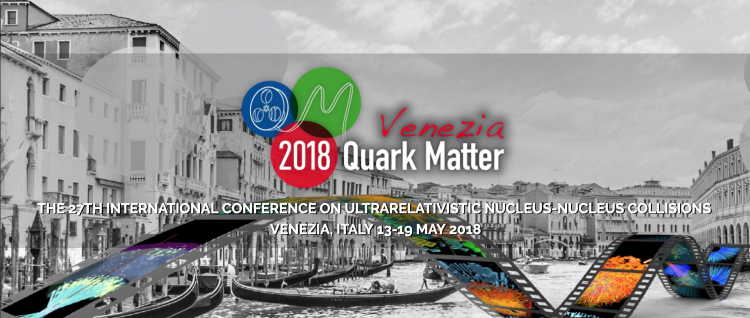
The CMS collaboration came to this year’s Quark Matter conference with fourteen new results, never shown before, and five other results recently submitted for publication. The majority of them exploit the high luminosity 8.16 TeV pPb, and 5.02 TeV pp and PbPb data delivered by the LHC in 2016 and 2015, respectively. Three of the analyses use the XeXe data at 5.44 TeV delivered during a 1 day run in October 2017.
The XeXe data show that the charged-particle production depends on collision geometry, not the system size. CMS continues to investigate collective effects (in which many particles in the event are correlated) in small systems, searching for the onset of these effects in events with a small multiplicity and also for similar effects in events which produce particles with relatively large mass or momentum. Significant v2 (a measure of azimuthal anisotropy) is observed in high-multiplicity pPb collisions for particles with either a single charm quark (D0) or a charm-anticharm pair (J/Psi). CMS reports also the first v3 measurement using 4-particle cumulants in pPb collisions, providing further evidence that v2 and v3 in pPb collisions are caused by initial state fluctuations.
The first measurement is reported of the detailed shapes of jets (sprays of particles created by a high momentum quark or gluon) in events with a back-to-back photon+jet pair. The results show that some of the energy in the core of the jet is redistributed to large distances from the jet axis. At the same time, the analysis of jet substructure shows that the overall distribution of particles in the core itself is hardly affected by the medium. For heavy quark studies, the first measurement of the radial profile of D mesons in jets in heavy ion collisions is reported. CMS continues to enrich its program of studying b (beauty) quarks, by adding the first measurement of Bs mesons and D mesons from the decay of beauty hadrons (called non-prompt D). For particles with charm-anticharm pairs, the measurement of Psi(2S) and J/psi mesons in PbPb, pPb, and pp collisions at 5.02 TeV reveals that the production of the Psi(2S) is suppressed with respect to J/psi in both pPb and PbPb.
The nPDFs are studied at high precision using W bosons and pairs of jets in pPb collisions at 8.16 and 5.02 TeV, respectively. The W boson results constrain the quark and antiquark nPDFs, while the dijet results represent the first evidence that the gluons which carry a large longitudinal momentum fraction in lead ions are strongly modified. The first experimental observation of the top quark in nuclear collisions is also presented. CMS reports also on the scattering of a photon from one Pb nucleus off of a photon from the other (so called light-by-light scattering) in ultraperipheral PbPb collisions.
All of the latest CMS results can be found at https://cms-results.web.cern.ch/cms-results/public-results/publications/.
All of the latest CMS heavy-ion results can be found at https://cms-results.web.cern.ch/cms-results/public-results/publications/HIN/index.html and https://cms-results.web.cern.ch/cms-results/public-results/preliminary-results/HIN/index.html
1. HIN-16-016 Studies of beauty suppression via measurements of nonprompt D0D0 mesons in PbPb collisions at √sNN= 5.02 TeV
2. HIN-17-004 Multiparticle correlations and higher order harmonics in pPb collisions at √sNN= 8.16 TeV
3. HIN-17-006 Pseudorapidity distributions of charged hadrons in XeXe collisions at √sNN= 5.44 TeV
4. HIN-17-007 Constraints on nuclear parton distributions from W boson production in pPb collisions at √sNN= 8.16 TeV
5. HIN-17-008 Measurement of the Bs0 meson nuclear modification factor in PbPb collisions at √sNN= 5.02 TeV
6. HIN-18-001 Charged particle angular correlations in XeXe collision at sNN‾‾‾√=sNN= 5.44 TeV
7. HIN-18-004 Charged-particle nuclear modification factors in XeXe collisions at √sNN= 5.44 TeV
8. HIN-18-006 Jet shapes for isolated photon-tagged jets in PbPb and pp collisions at √sNN= 5.02 TeV
9. HIN-18-007 Measurement of the radial profile of D0 mesons in jets produced in pp and PbPb collisions at 5.02 TeV
10. HIN-18-010 Observation of prompt J/ψ meson elliptic flow in high-multiplicity pPb collisions at √sNN=8.16 TeV
11. HIN-18-012 “Production of prompt and nonprompt J/ψ mesons in jets in pp collisions at √s = 5.02 TeV”
12. HIN-18-015 Measurement of correlated azimuthal anisotropy Fourier harmonics with subevent cumulants in pPb collisions at 8.16 TeV
13. HIN-16-003 Constraining gluon distributions in nuclei using dijets in proton-proton and proton-lead collisions at √sNN= 5.02 TeV
14. HIN-16-015 Measurement of prompt ψ(2S) production cross sections in proton-lead and proton-proton collisions at √sNN= 5.02 TeV
15. HIN-16-023 “Measurement of nuclear modification factors of Υ(1S), Υ(2S), and Υ(3S) mesons in PbPb collisions at √sNN =5.02TeV”
16. HIN-16-024 Measurement of the groomed jet mass in PbPb and pp collisions at √sNN= 5.02 TeV
17. HIN-17-001 Constraints on the chiral magnetic effect using charge-dependent azimuthal correlations in pPb and PbPb collisions at the LHC
18. HIN-17-002 Observation of top quark production in proton-nucleus collisions
19. HIN-17-003 Elliptic flow of charm and strange hadrons in high-multiplicity pPb collisions at √sNN= 8.16 TeV
20. FSQ-16-012 “Measurement of light-by-light scattering in ultraperipheral PbPbcollisionsat√sNN =5.02TeV”
21. FSQ-15-009 “Femtoscopic Bose-Einstein Correlations of charged hadrons in proton-proton collisions at √s = 13 TeV“
- Log in to post comments

